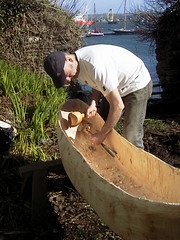The main source is the Small Passenger Boat Code.
Firstly, our territorial waters are divided into four categories.
Category A: Narrow rivers and canals
Category B: Wider rivers and canals
Category C: Tidal rivers and estuaries where significant wave height <>
Category D: Same, but significant wave height is <>
Merchant Shipping Notice 1776 defines all "non sea" waters in the UK into the appropriate category.
It is necessary to decide which waters one wishes to work as the required inventory is differenct depending on categorisation.
Procedure:
- Apply for a Medical Report Form ML5 - cost £65
- Obtain liability insurance - Cheers Insurance are really helpful
- Apply to Cornwall Council (for the Fal Estuary) for a Licence before April 1 - cost £50
- Instruct a condition survey using list of potential surveyors provided by the Council
- Apply for a Boatman's Licence
- Carve a sign using letters one inch high and three quarters of an inch wide stating name of operator, intended area of operation, name of boat and maximum number of passengers.
- Leave space on bow of boat to paint registration number in four inch high numerals
Safety Equipment for SW Category 1 - ie operating in Cat C and D waters between sunrise and sunset and between April 1 and october 31:
- Painter
- Bilge Pump, bailer and bucket
- Lifejackets for all crew and passengers (buoyance aids possible 100N)
- Alternative means of propulsion - sculling oar and two pairs of paddles
- One lifebuoy
- Approved buoyant apparatus
- Anchor and rope
In addition, it is prudent to carry:
- First Aid kit
- Fog horn
- Whistle
- Navigation lights
- Torch
- Tool kit
- Distress flares
- VHF radio
- Heaving line
Questions:
What needs to be displayed on the boat?
Are Buoyancy aids of 100N acceptable?
What is the maximum insured third party liability cover?
Buoyant apparatus - define. Fenders?
